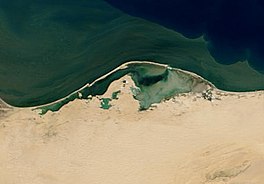| Lake Bardawil | |
|---|---|
 Satellite Image of Lake Bardawil | |
| Coordinates | 31°11′26″N 33°09′44″E / 31.190483°N 33.162231°E |
| Surface area | 59,500 ha (147,000 acres) |
| Designated | 9 September 1988 |
| Reference no. | 407[1] |

Lake Bardawil (Arabic: بحيرة البردويل, romanized: Buḥayrat al-Bardawīl or سبخة البردويل Sabḵat al-Bardawīl), is a large, very saline lagoon nearby the protected area of Zaranik (also known for diversities of insects[2] and waterbirds[3][4]) in Egypt on the north coast of the Sinai Peninsula. Lake Bardawil is about 30 kilometers (19 mi) long, and 14 kilometers (8.7 mi) wide (at its widest). It is considered to be one of the three major lakes of the Sinai Peninsula, along with the Great Bitter Lake and the Little Bitter Lake.[5] It continues to decrease in size as sands move and is becoming more of a Playa or Sabkha than a lake.[6] Between Port Said and Rafah are three main sabkha which extend from west to east: Sabkhat El Malaha (Lake Fouad), Sabkhat Bardawil (Lake Bardawil) and Sabkhat El Sheikh Zawayed.[7]
It is shallow, reaching a depth of about 3 meters, and is separated from the Mediterranean Sea by a narrow sandbar and often the waters of the sea find their way there, making it saline.[6][8] It has International Ramsar Convention protected wetlands with a large population of little tern.[9] 30% of the recorded species in the Mediterranean Coast of Sinai are in Lake Bardawil. Six threatened species of flora exist at Lake Bardawil, including Iris mariae.[6]
It has six habitats including "open water, wet salt marshes, saline sand flats and hummock (nebkas), stabilized sand dunes, interdune depressions, and mobile sand dunes."[6]
Other than bird diversity, the area is known for sea turtles and bottlenose dolphins[10] although high mortality rate of sea turtles has been concerning.[11] Within IUCN Red Data Book of 2006 are 6 threatened plant species which are found near the Lake, these include Astragalus camelorum, Bellevalia salah-eidii, Biorum oliveri, Iris mariae, Lobularia arabica and Salsola tetragona. The first four are endemic species.[12]
Some students of the Hebrew Exodus out of Egypt think that this location is near the fourth station of the Exodus, called Pi-hahiroth, saying "it may have been just west of the Western tip of Lake Bardawil."[13]
It may be what Herodotus described as the Serbonian Bog, between Damietta and Mount Casius, in his Histories of c. 430BCE.[14][15]
The Bardawil lagoons are named after the Crusader king Baldwin I.[16] Based in Jerusalem, Baldwin raided Egypt in order to secure his kingdom. He fell ill while fishing in the Nile. While being carried back to Jerusalem in 1118 CE, Baldwin died in El-Arish.[16]
During the Sinai and Palestine campaign of World War I, Allied soldiers of the Canterbury Mounted Rifles tried to cut a canal from the sea to the western end of Lake Bardawil in order to flood it and prevent forces of the Central Powers attacking Romani from the north, but they were unsuccessful.[17]
- ^ "Lake Bardawil". Ramsar Sites Information Service. Retrieved 25 April 2018.
- ^ El-Moursy A.. El-Hawagry M.. Abdeldayem M.. Fadl H.. 2001. Insect Diversity in Zaranik Protectorate, Northern Sinai, Egypt (pdf). Egyptian Journal of Natural History. Vol. 3 (2001). pp.62-80. Retrieved on September 09, 2017
- ^ BirdLife International. Important Bird Areas factsheet: Zaranik Protected Area. Retrieved on September 09, 2017
- ^ Tour Egypt. Zaranik Protected Area in Egypt. September 09, 2017
- ^ Kusky, Timothy M. (May 14, 2014). Encyclopedia of Earth Science. New York Academy of Sciences. p. 387. ISBN 9781438110042. Retrieved 11 November 2016.
- ^ a b c d Zahran, M.A.; Willis, A.J. (November 23, 2008). The Vegetation of Egypt. Springer Science & Business Media. ISBN 9781402087561.
- ^ Khan, M. Ajmal; Böer, Benno; Kust, German S.; Barth, Hans-Jörg (Aug 27, 2008). Sabkha Ecosystems: Volume II: West and Central Asia. Springer Science & Business Media. ISBN 9781402050725. Retrieved 11 November 2016.
- ^ "Lake Bardawil on Northern Shores of Sinai Peninsula, Egypt – December 5th, 2010". Earth Snapchat. Archived from the original on 2016-11-11.
- ^ "Lake Bardawil - Marine (2016) Important Bird Areas Factsheet". Birdlife International. Archived from the original on 2016-11-11.
- ^ Nada M.A.. Boura L.., Grimanis K.. Schofield G.. El-Alwany A. M.. Noor N.. Ommeran M. M.. Rabia B.. 2013. Egypt's Bardawil Lake: safe haven or deadly trap for sea turtles in the Mediterranean? Archived 2017-09-08 at the Wayback Machine. MEDASSET, Suez Canal University, Nature Conservation Egypt.
- ^ IUCN. 2014. Conservation of Bardawil Wetland and sea turtles in Egypt .Retrieved on September 09, 2017
- ^ M.A. Zahran and A.J. Willis The Vegetation of Egypt, p. 228, at Google Books
- ^ Hobbs, Joseph J. (February 19, 2014). Mount Sinai. University of Texas Press. ISBN 9780292761513. Retrieved 11 November 2016.
- ^ Milton, John; Kastan, David Scott (2005). Paradise Lost (Kastan ed.). Hackett Publishing. p. 62. ISBN 9781603843980. Retrieved 11 November 2016.
- ^ Lane Fox, Robin (September 4, 2008). Travelling Heroes: Greeks and their myths in the epic age of Homer. Penguin UK. ISBN 9780141889863.
- ^ a b Sebag Montefiore, Simon, 1965- (2011). Jerusalem : the biography (1st American ed.). New York: Alfred A. Knopf. ISBN 9780307594488. OCLC 763182492.
{{cite book}}: CS1 maint: multiple names: authors list (link) CS1 maint: numeric names: authors list (link) - ^ Kinloch, Terry (2007). Devils on Horses in the Words of the Anzacs in the Middle East,1916–19. Auckland: Exisle Publishing. ISBN 978-0-908988-94-5.
